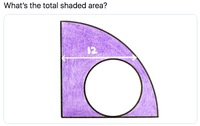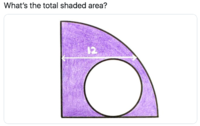You are using an out of date browser. It may not display this or other websites correctly.
You should upgrade or use an alternative browser.
You should upgrade or use an alternative browser.
Find the area of the shaded region
- Thread starter AJPL88
- Start date
D
Deleted member 4993
Guest
Please follow the rules of posting in this forum, as enunciated at:View attachment 18059
Can I have some help with this problem?
https://www.freemathhelp.com/forum/threads/read-before-posting.109846/#post-486520
Please share your work/thoughts about this assignment
Please show us what you have tried and exactly where you are stuck.

Dr.Peterson
Elite Member
- Joined
- Nov 12, 2017
- Messages
- 16,869
This is the sort of problem that initially looks as if there is not enough information, since you don't know either radius. But assuming it can be solved, we can just do whatever we can and expect some magic to occur ...View attachment 18059
Can I have some help with this problem?
... and it will!
Give a name to each unknown radius, maybe R and r. Write an expression for the shaded area in terms of those variables. Then look for an equation you can write that relates the two variables -- using that horizontal line of length 12 units that just touches the top of the small circle.
(We have to assume that the picture is what it looks like, without having been told -- an exact quarter circle containing a circle.)
Dr.Peterson
Elite Member
- Joined
- Nov 12, 2017
- Messages
- 16,869
Yes, it is. In fact, I'd call it a trick question.Cute problem.
The tricky part is that the 12 at first looks like a mere dimension, until you realize that its location depends on its being a horizontal line tangent to the small circle. And the location of the small circle (horizontally) doesn't even matter, though one might assign a variable to that, too, only to find that you never use it.
If length a is the radius of the larger circle and length r is the radius of the smaller circle, we can see that the 12 line forms a right triangle with a line length a and the vertical side of the quarter circle. The vertical side is two times length r, so we can use the Pythagorean Theorem and get 122+(2r)2=a2. Therefore, a=sqrt(144+4r2). The area of the full circle would be 144pi+4pi*r2. The area of the quarter circle is 36pi+pi*r2. The area of the smaller circle would be pi*r2. Subtracting the two from each other would get 36pi, the area of the shaded region.
Last edited by a moderator:
Dr.Peterson
Elite Member
- Joined
- Nov 12, 2017
- Messages
- 16,869
That's correct, @comrade, but you've missed the fact that we're trying to help people figure out their problems themselves, not to show a complete solution before they even have time to respond to hints.
Posting Guidelines (Summary)
Welcome to our tutoring boards! :) This page summarizes main points from our posting guidelines. As our name implies, we provide math help (primarily to students with homework). We do not generally post immediate answers or step-by-step solutions. We don't do your homework. We prefer to help...
www.freemathhelp.com
LCKurtz
Full Member
- Joined
- May 3, 2019
- Messages
- 475
What I like about the problem is the fact that if it were given on a (multiple choice, online) exam where there was time pressure you could reasonably make the assumption that the answer is independent of the two radii. If the radius of the small circle is [MATH]0[/MATH] you can get the answer [MATH]36\pi[/MATH] in your head.
Dr.Peterson
Elite Member
- Joined
- Nov 12, 2017
- Messages
- 16,869
Yes, that could be a definition of "cute"; a recent problem about three squares, and the old one about a hole through a cylinder, have the same feature. But if such a problem were given on a test, we'd be encouraging students to make assumptions justified only by the human context, not be the math, and therefore to do something other than math. Nice, yet not nice!
LCKurtz
Full Member
- Joined
- May 3, 2019
- Messages
- 475
A real life example of this kind of unintended shortcut happened to me when I was in the 7th grade. This was back in the stone age when they used the "Iowa" tests to evaluate how everyone was doing. Our English teacher gave us this test for reading speed and comprehension. It was a timed test. The rules were to read the paragraph and answer the question. If you didn't get it the first time the idea was to re-read the question, taking the time to get the answer right. Then on to the next question. Hurry, get as many done as you can. After doing the first question it hit me to read the question before reading the paragraph. Often, as a result, I didn't have to read the whole paragraph, and never had to re-read to get the answer.
The next day the teacher came back beaming and announced that the littlest kid in the class (me) got the highest score in both reading speed and comprehension. I never told anyone how I did it and I've often wondered how the conversation in the teacher's lounge went that day.
The next day the teacher came back beaming and announced that the littlest kid in the class (me) got the highest score in both reading speed and comprehension. I never told anyone how I did it and I've often wondered how the conversation in the teacher's lounge went that day.

